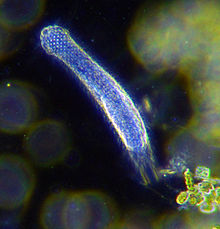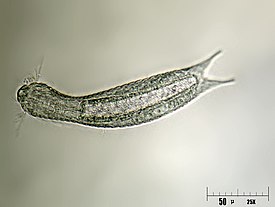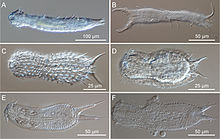Gastrotrich
| Gastrotrich | |
|---|---|

| |
| Darkfield photograph of a gastrotrich | |
| Scientific classification | |
| Domain: | Eukaryota |
| Kingdom: | Animalia |
| Subkingdom: | Eumetazoa |
| Clade: | ParaHoxozoa |
| Clade: | Bilateria |
| Clade: | Nephrozoa |
| (unranked): | Protostomia |
| (unranked): | Spiralia |
| Clade: | Rouphozoa
|
| Phylum: | Gastrotricha Metschnikoff, 1865[1] |
| Orders | |
The gastrotrichs (
Gastrotrichs have a simple body plan with a head region, with a brain and
Etymology and taxonomy
The name "gastrotrich" comes from the Greek γαστήρ gaster, meaning "stomach", and θρίξ thrix, meaning "hair".[2] The name was coined by the Russian zoologist Élie Metchnikoff in 1865.[1] The common name "hairyback" apparently arises from a mistranslation of "gastrotrich".[3]
The relationship of gastrotrichs to other phyla is unclear. Morphology suggests that they are close to the Gnathostomulida, the Rotifera, or the Nematoda. On the other hand, genetic studies place them as close relatives of the Platyhelminthes, the Ecdysozoa or the Lophotrochozoa.[4] As of 2011, around 790 species have been described.[5] The phylum contains a single class, divided into two orders: the Macrodasyida and the Chaetonotida.[6] Edward Ruppert et al. report that the Macrodasyida are wholly marine,[6] but two rare and poorly known species, Marinellina flagellata and Redudasys fornerise, are known from fresh water.[7] The Chaetonotida comprises both marine and freshwater species.[6]
Anatomy

Gastrotrichs vary in size from about 0.06 to 3 mm (0.002 to 0.118 in) in body length.

The body wall consists of a
The mouth is at the anterior end and opens into an elongated muscular
In the chaetonotidans, the excretory system consists of a single pair of
As is typical for such small animals, there are no respiratory or circulatory organs. The nervous system is relatively simple. The brain consists of two ganglia, one on either side of the pharynx, connected by a commissure. From these lead a pair of nerve cords which run along either side of the body beside the longitudinal muscle bands. The primary sensory organs are the bristles and ciliated tufts of the body surface which function as mechanoreceptors. There are also ciliated pits on the head, simple ciliary photoreceptors and fleshy appendages which act as chemoreceptors.[6]
Distribution and habitat

C, D, E & F = Chaetonotida
Gastrotrichs are cosmopolitan in distribution. They inhabit the interstitial spaces between particles in marine and freshwater environments, the surfaces of aquatic plants and other submerged objects and the surface film of water surrounding soil particles on land.[4] They are also found in stagnant pools and anaerobic mud, where they thrive even in the presence of hydrogen sulfide. When pools dry up they can survive periods of desiccation as eggs, and some species are capable of forming cysts in harsh conditions.[9] In marine sediments they have been known to reach 364 individuals per 10 cm2 (1.6 sq in) making them the third most common invertebrate in the sediment after nematodes and harpacticoid copepods. In freshwater they may reach a density of 158 individuals per 10 cm2 (1.6 sq in) and are the fifth most abundant group of invertebrates in the sediment.[4]
Behaviour and ecology
In marine and freshwater environments, gastrotrichs form part of the
Like many microscopic animals, gastrotrich locomotion is primarily powered by
Reproduction and lifespan

Gastrotrich reproduction and reproductive behaviour has been little studied. That of
Many species of chaetotonid gastrotrichs reproduce entirely by
Gastrotrichs demonstrate eutely, each species having an invariant genetically fixed number of cells as adults. Cell division ceases at the end of embryonic development and further growth is solely due to cell enlargement.[6]
Classification
Gastrotricha is divided into two orders and a number of families:[1][4]
|
Order Macrodasyida Remane, 1925 [Rao and Clausen, 1970]
|
Order Chaetonotida Remane, 1925 [Rao and Clausen, 1970] Suborder Multitubulatina d'Hondt, 1971
Suborder Paucitubulatina d'Hondt, 1971
|
References
- ^ a b c Todaro, Antonio (2013). "Gastrotricha". WoRMS. World Register of Marine Species. Retrieved 2014-01-26.
- ^ "Gastrotrich". The Free Dictionary. Retrieved 2014-01-29.
- ISBN 978-0-7011-8180-2.
- ^ a b c d e f Todaro, M. A. (2014-01-03). "Gastrotricha". Retrieved 2014-01-23.
- (PDF) from the original on 2022-10-09.
- ^ ISBN 978-81-315-0104-7.)
{{cite book}}: CS1 maint: multiple names: authors list (link - PMID 22348127.
- ISBN 0-03-056747-5.
- ISBN 978-0-85199-661-5.
- .
External links
- Gastrotrichs in the Encyclopedia of Life
